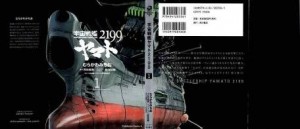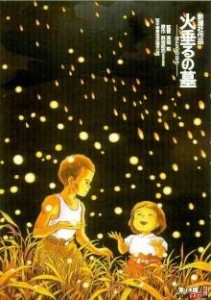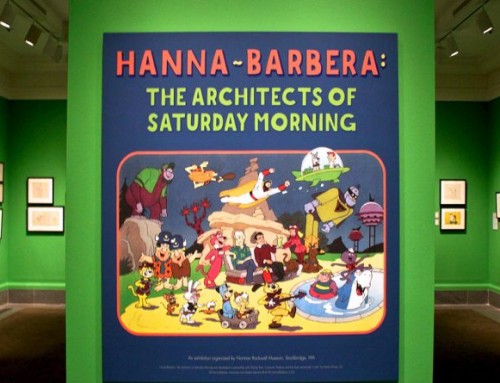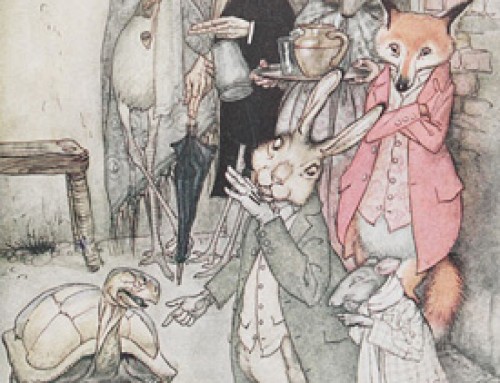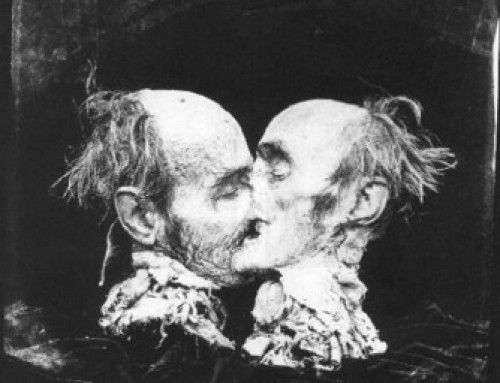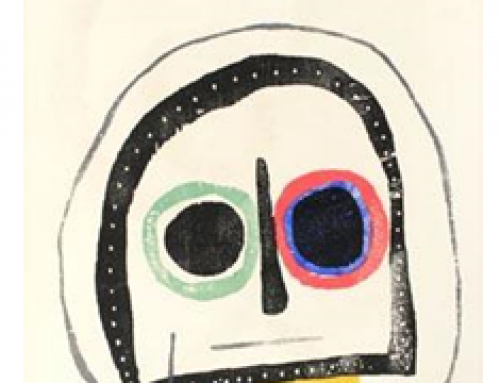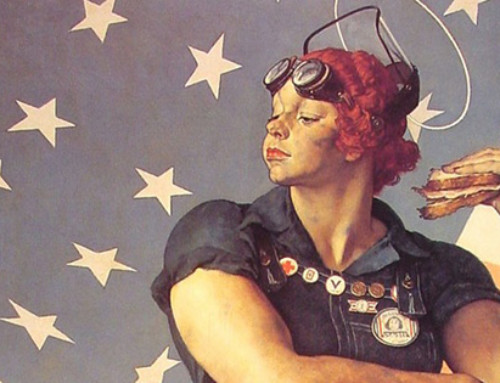By Eric Ruiji Li, grad student MICA’s Illustration Practice, Fall 2013, Critical Seminar, Final Paper
World War II, which was the biggest war in past hundred years, influenced most countries and brought a tremendous change to world politics. Japan, a vanquished country who waged a war of aggression on its Asian neighbors, experienced a huge decline from being one of the strongest countries in the region to being a ruined land. During this process, the belief of “the glorious and unbeatable Yamato” was broken by the ruthless reality, and their great leader Mikado became a war criminal. The spirit of the Japanese people collapsed. People were defeated, lost, angered and numb–the war had become a bitter and unforgettable experience. In this turbulent period, the future Japanese comic masters grew up. They listened, watched, and felt introspective about the war and the future of their nation. Within Japanese society’s renaissance, they had an opportunity to provide their own answers by creating various types of comic works, that helped the people to think deeply about their contemporary world. This paper examines several representative comic works, to explore how these works connected to and expressed the Japanese spirit.
1. The sense of crises
Japan is a small country. Considering its population: Japan always has been overcrowded. Without enough natural resources, Japan relies on importing various materials to live. An island country, Japan experiences natural disasters, such as tsunamis and earthquakes all the time. These challenges leave the Japanese with a heightened sense of crisis. This reality became more pronounced after Japan lost the war, and its people were worried about their nation’s existence. There are number of comics from this post-war period that show their worry about survival. This paper focuses on two of these comics.
Leiji Matsumoto (b. 1938)
Space Battleship Yamato, 1974
Leiji Matsumoto created Space Battleship Yamato in 1974. It is a science fiction animation focused on the future survival of humanity. The story is about a future earth which is attacked by aliens who have a more highly developed technology than humans. All of the countries are ruined and the surface of earth looks like Mars and is full of radioactive rays. The Earth Space Fleet is completely destroyed in just one battle, and humans may now only live under ground. Knowing modern Japanese history, it is easy to see that this story reflects Japan after WWII– cities were bombed, the army was dissolved, and two nuclear bombs destroyed vast area of their land. Another alien civilization sends a message to earth, telling people that they have a machine called “the space clearer” which could recover the earth in a second. What the humans should do is going to that planet and bring the machine back. This is the last hope for human, and this great mission is taken by the battleship Yamato (the author cleverly reused the name of a famous Japanese battleship that was destroyed during the WWII.)
Kazuo Umezu (b. 1936)
The Drifting Classroom, 1972
Another comic that had a huge influence in Japan is The Drifting Classroom, by Kazuo Umezu which also focused on living under threat. The story is about Sho Takamatsu, a sixth grader, who has somehow been transported into a waste land with his school and classmates. In the face of this unexpected and frightening change, the adults in the school break down because they cannot accept that the American army will not save them. Most of them adults died in accidents, and the rests start looting resources and killing each other for the right of control. (“The Drifting Classroom.” The Drifting Classroom. Trans. Ruiji Li. N.p., n.d. Web. 11 Dec. 2013. <https://zh.wikipedia.org/wiki/%E6%BC%82%E6%B5%81%E6%95%99%E5%AE%A4>.) This story is a mirror of real Japan after defeat. Most people could not accept their loss and humiliation. The careerists plotted against each other, and lower-class people hoped for the American army’s help. Japanese society was in chaos in a long time. In spite of the history of desperation, the author set good will into the story. As the story develops, some of the children have been sacrificed during several difficulties, but there are still a little group that survives. They find that the place they are in is the future earth, which has been ruined by human’s unlimited desires. Further more, they realize that they are the seed of a new history, they are transported to this deserted world by the destiny. By the end of the story, these children decide to embrace their fate, trying to create a new tomorrow.
2. The introspections
After WWII, the lesson all participating countries learned was that there were no winners in war; this was especially true in Japan. Facing their broken home, some Japanese realized they had been enticed by militarism and had done unforgivable things. Some comic masters were influenced by these regrets and we can find the traces of this in their works.
Grave of the Fireflies by Akiyuki Nosaka was first a semi-autobiographical novel and recomposed into an animated movie in 1988. The story came from the author’s real experience. After eluding the bombing of Kobe, the author left home with his little sister, starting on an aimless journey. Just like the movie, his little sister unfortunately died of malnutrition. In the movie the protagonist is a perfect brother who is considerate of his sister. But the opposite was true, when a boy, the author didn’t take good care of his sister, he even hit her on head when she cried. When she died, the remembered bony body and the pale face of his sister made a deep impression. He couldn’t forgive himself for a long time, so he gave all his love to the character girl in expiation. For this reason many of the audiences cried when they watch the movie. But this movie caused a dispute when it showed in China. Because there were scenes that described the Japanese’s miserable lives after the war, some people thought this movie showed Japan as a victim, and was trying to gain sympathy. (Li, Yang. “The Japanese.” Xinhua Bookstore, n.d. Web. 13 Dec. 2013.) This idea was not wrong, but they really put their focus on the wrong point.
Anyone who has enjoyed Japanese comics should know of Miyazaki Hayao. He is the synonym of Japanese animation circle. He has too many great works to pick one as representative. But all of his works have a same feature: you can never see the absolute good and evil. For Miyazaki Hayao there is no dualism. All the bad characters have their good points. For example, the no-face in Spirited Away (by Miyazaki Hayao, 2001), who symbolizes humans’ desire, could be huge and horrible, but after the protagonist Ogino helps, it becomes a quiet and cute spirit. Miyazaki Hayao was influenced deeply by something that happened in his childhood. After saving lives from American air attack, his family was given an old car. By the time the car was taking on speed, Miyazaki saw his neighbor with a child calling for help and trying to get on their car. But the cruel fact was there was no more space to let even a child in the car. Spent, the neighbor fell down with the child, but his father even wouldn’t even look. (Wang, Naizhen. “The Story of the Masters in Japanese.” N.p., n.d. Web. 11 Dec. 2013. <https://www.u17.com/>.) This scene impacted Miyazaki. In his work, humanity is always portrayed as complicated, and things happen in contradiction. He believes in the positive energy of humanity, but to reach a good ending, there are sacrifices in both the physical and spiritual spheres.
3. Resentful comics about war
As time passed, the wounds of war were healed slowly. People still remember the war, but there is a change in their attitudes, which is reflected in Japanese comics. The new generation artists didn’t experience the war, so they could hardly feel the weight of that history. In their eyes, the war is a good commercial topic to attract readers but not such a serious business. While their works are good, they lack the same depth. And even though the Japanese government never apologized to their Asian neighbors who were hurt in the war, the comic and animation artists did not avoidtheir mistake. The comic work Sergeant Keroro and Squid Girl are two examples.
Mine Yoshizaki (b.1971) Masahiro Anbe (b.1983)
Sergeant Keroro, 1999 Squid Girl, 2007
If you only look at their cute faces, you would not think that they are aggressors, but they really are. The little frog comes from another planet in Gamma Planet System and the lovely girl comes from the deep sea. The authors shaped these aggressors in with naivety and romantic children’s features. This is one of the selling points, but it is not done to beautify aggression. On the contrary, these are just a mock pose, because as an aggressors, these characters are totally incompetent. During their so-called aggressive strategies, they don’t hurt anyone or cause any damages, but they become friends with people, help people, and spend their day full of laughter. They have superhuman technologies and abilities, but every time they believed ‘this time, I will control the earth’, they go off on the wrong direction half way and finally help the world to become better. In this way, the authors transform the thoughts of aggression of young people into a lighter perspective
All in all, after WWII, Japan experienced a miserable transition time into the country they now are. The Japanese people’s struggle offered the soil for artists seeking materials from their lives, and that directly influenced the directions of these comic and animation works that were created after the war.
Bibliography
Fujin, Makouto. “The Great Ship Yamato.” Kadokawa Shoten, Trans. Ruiji Li .N.p.n.d. Web. 11 Dec. 2013.
Li, Yang. “The Japanese.” Xinhua Bookstore, Trans. Ruiji Li.N.p.n.d. Web. 13 Dec. 2013.
Wang, Naizhen. “The Story of the Masters in Japanese.” Trans. Ruiji Li.N.p., n.d. Web. 11 Dec. 2013. <https://www.u17.com/>.
“The Drifting Classroom.” The Drifting Classroom. Trans. Ruiji Li. N.p., n.d. Web. 11 Dec. 2013. <https://zh.wikipedia.org/wiki/%E6%BC%82%E6%B5%81%E6%95%99%E5%AE%A4>.
Image resources:
Akiyuki Nosaka, Grave of the Fireflies, 1967
Kazuo Umezu, The Drifting Classroom, 1972
Leiji Matsumoto, Space Battleship Yamato, 1974
Masahiro Anbe, Squid Girl, 2007
Mine Yoshizak, Sergeant Keroro, 1999
Miyazaki Hayao, Spirited away, 2001


